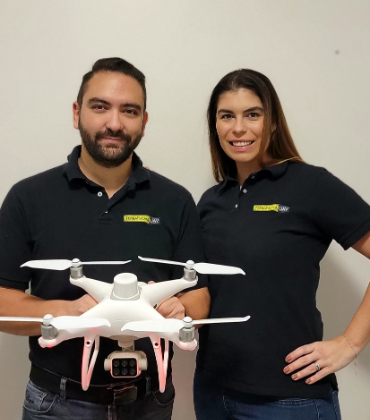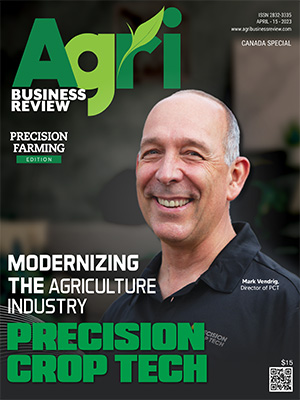Aerial imagery in production agriculture has continued to grow and evolve over the last few years. Aerial imaging systems have had a great range of applications on farms, providing farmers with information on the water system, soil variety, pests, and fungal infestation. Leveraging this technology can enable them to increase productivity and make the most of their property.
Terranova UAV was founded with the mission of helping farmers optimize crops using state-of-the-art UAV technology. The Canadian agricultural drone service company provides actionable insights to reduce input costs and emissions and increase yields.
“Our team has developed a service offering that integrates the best of drone technology, multispectral imagery, photogrammetry, and AI. This equips farmers with the information they need in the form of detailed maps, closeup pictures, and support focused on the decisions that drive value in the field,” says Andres Hurtado, co-founder, Terranova UAV.
The Terranova team uses drones equipped with multispectral cameras to automatically collect field images. Each image is georeferenced to obtain a centimeter-level accurate plant location. This acquired information is processed using the latest mapping software, AI, cloud computing, and agricultural knowledge to develop plant algorithms that turn into live maps to provide insights on plants, including plant health, biomass, plant counts, seed germination rates, weed, pest, and disease detection.
The drone technology, combined with high-resolution, low-altitude drone georeferenced imagery, allows Terranova to examine specific areas of concern and determine the need for additional studies or tissue sampling. This saves scouts the time they spend walking the fields and offers a faster method to diagnose issues. In addition, it adds a layer of safety by removing the need for physical contact with the plants, eliminating the risk of carrying pathogens, contaminating other fields, and damaging crops.
Terranova’s drones are operated by fully trained and licensed pilots to fly across multiple fields, ensuring its capability to provide results in less than 48 hours for timely decision-making and accurate diagnoses.
The confluence of cutting-edge technology and superior customer service puts Terranova a cut above the rest. It provides personalized assistance to every client through proper conversations, gathering an in-depth understanding of their issues for the disposal of timely information that helps with decision-making.
In one instance, Terranova produced a visible spectrum and plant health maps to evaluate the general plant health of a corn crop in Western Ontario. Since it was a late-season study, the older plants indicated early maturity due to richer soil at the beginning of the season. This study helped detect protein-deficient areas, enabling focused fertilizer application on critical areas for optimal plant health. This allowed clients to optimize nutrients and obtain higher yields, thanks to uniform fertility across the field.
The study also performed a late-stage plant count using an advanced plant population mapping system. This report, enhanced by ground sampling, enabled them to efficiently estimate yields with high precision.
“During this mission, we found plague-infested zones, which helped our client take immediate action to eradicate them. We also performed a dry matter study to determine the nutrient composition in plants,” says Amanda Gloor, partner, Terranova. “We are flexible and customized to accommodate our clients’ needs. We constantly look for feedback to improve our customer service and help them find solutions that work.”
Today, with the increasing push for “farm to plate,” the need for better traceability is a mandate as customers show rising concerns about the sources of food they buy and consume. A company like Terranova ticks all the boxes to fulfil this requirement while ensuring higher profitability, improved sustainability, and increased productivity for farmers.
Terranova UAV was founded with the mission of helping farmers optimize crops using state-of-the-art UAV technology. The Canadian agricultural drone service company provides actionable insights to reduce input costs and emissions and increase yields.
“Our team has developed a service offering that integrates the best of drone technology, multispectral imagery, photogrammetry, and AI. This equips farmers with the information they need in the form of detailed maps, closeup pictures, and support focused on the decisions that drive value in the field,” says Andres Hurtado, co-founder, Terranova UAV.
The Terranova team uses drones equipped with multispectral cameras to automatically collect field images. Each image is georeferenced to obtain a centimeter-level accurate plant location. This acquired information is processed using the latest mapping software, AI, cloud computing, and agricultural knowledge to develop plant algorithms that turn into live maps to provide insights on plants, including plant health, biomass, plant counts, seed germination rates, weed, pest, and disease detection.
The drone technology, combined with high-resolution, low-altitude drone georeferenced imagery, allows Terranova to examine specific areas of concern and determine the need for additional studies or tissue sampling. This saves scouts the time they spend walking the fields and offers a faster method to diagnose issues. In addition, it adds a layer of safety by removing the need for physical contact with the plants, eliminating the risk of carrying pathogens, contaminating other fields, and damaging crops.
Terranova’s drones are operated by fully trained and licensed pilots to fly across multiple fields, ensuring its capability to provide results in less than 48 hours for timely decision-making and accurate diagnoses.
The confluence of cutting-edge technology and superior customer service puts Terranova a cut above the rest. It provides personalized assistance to every client through proper conversations, gathering an in-depth understanding of their issues for the disposal of timely information that helps with decision-making.
In one instance, Terranova produced a visible spectrum and plant health maps to evaluate the general plant health of a corn crop in Western Ontario. Since it was a late-season study, the older plants indicated early maturity due to richer soil at the beginning of the season. This study helped detect protein-deficient areas, enabling focused fertilizer application on critical areas for optimal plant health. This allowed clients to optimize nutrients and obtain higher yields, thanks to uniform fertility across the field.
Our team has developed a service offering that integrates the best of drone technology, multispectral imagery, photogrammetry, and artificial intelligence
The study also performed a late-stage plant count using an advanced plant population mapping system. This report, enhanced by ground sampling, enabled them to efficiently estimate yields with high precision.
“During this mission, we found plague-infested zones, which helped our client take immediate action to eradicate them. We also performed a dry matter study to determine the nutrient composition in plants,” says Amanda Gloor, partner, Terranova. “We are flexible and customized to accommodate our clients’ needs. We constantly look for feedback to improve our customer service and help them find solutions that work.”
Today, with the increasing push for “farm to plate,” the need for better traceability is a mandate as customers show rising concerns about the sources of food they buy and consume. A company like Terranova ticks all the boxes to fulfil this requirement while ensuring higher profitability, improved sustainability, and increased productivity for farmers.
Company : TerraNova UAV
Headquarters :
Ontario, Canada ManagementAndres Hurtado, Co-founder and Alexandra Acosta, Co-founder
Thank you for Subscribing to Agri Business Review Weekly Brief



